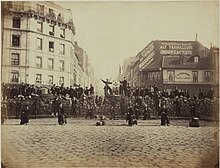barricade

A barricade is a protective wall in street fighting , which is usually improvised put together from objects from everyday life.
The term is derived from " barriques " (French: "barrels"). In the July Revolution of July 27, 1830, barricades were the main defense strategy of the Parisian population against the police of King Charles X. Almost 6,000 such barricades were counted during the uprising. Its foundation were barrels filled with earth. Everything that proved useful for defense was stacked and nailed on top. Mattresses served as a bullet trap. If the enemy was repulsed, there was no running around the barricade. Instead, paving stones were added to a ramp on the side of those seeking protection, which the rebels stormed over, giving the anger a dynamic expression. This is where the phrase “go to the barricades”, which is still used today, is derived.
Historically, the main purpose of barricades was that the insurgents, usually poorly armed, could make up for their inferior equipment against the military units. If the losses of the insurgents were nevertheless mostly considerable, then only barricade strategy offered any chance of success for an insurrection - open confrontations with the military would have been synonymous with a massacre. In Paris in particular, the city was restructured by Baron Georges-Eugène Haussmann during the 1860s so that modern artillery could easily be used in street combat. After the defeat of the Paris Commune in 1871, Friedrich Engels judged that the barricade against the newer military technology now had no chance. Auguste Blanqui, on the other hand, believed that the barricade was still a useful means of revolt at this time. In his view, its success depended on its design and the strategy into which it was incorporated. Blanqui drew up precise plans for massive barricades made of gravel and cobblestone that could both withstand the cannonade and would be difficult to take by the infantry. In addition, he developed whole strategies for street fighting. As late as 1936, during the Spanish Civil War, the barricade was an efficient tool and contributed significantly to the initial defense against the Franco coup . In the last decades barricades were mostly only used in disputes with police forces, whereby they still proved their effectiveness. B. in Paris May 1968 .

